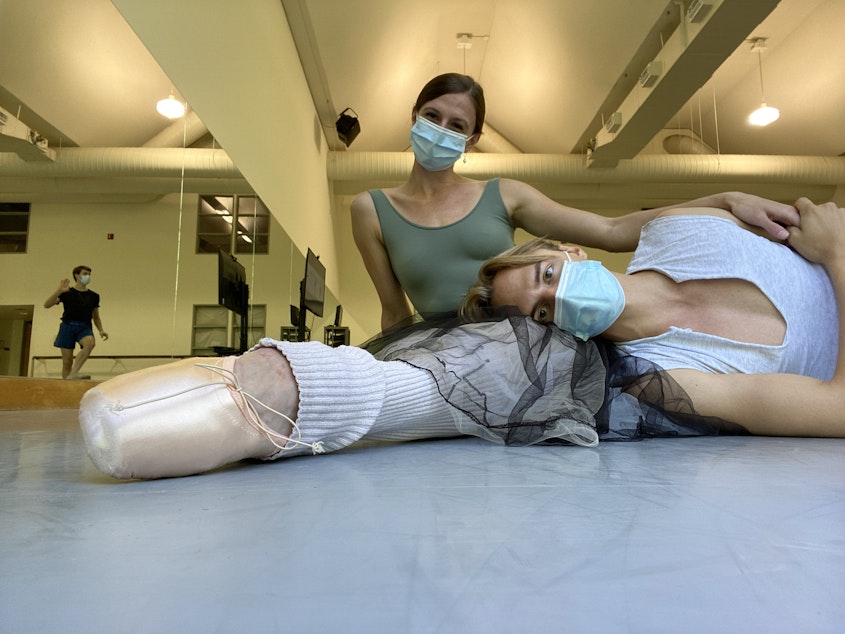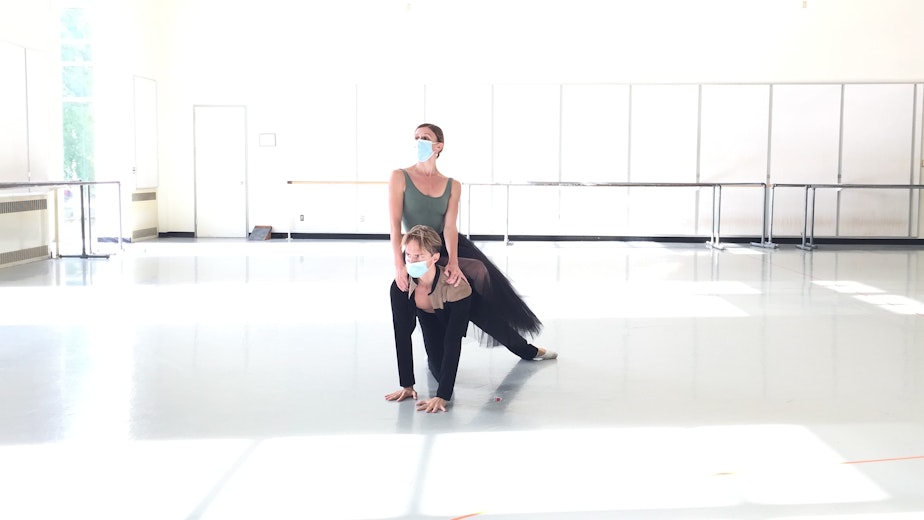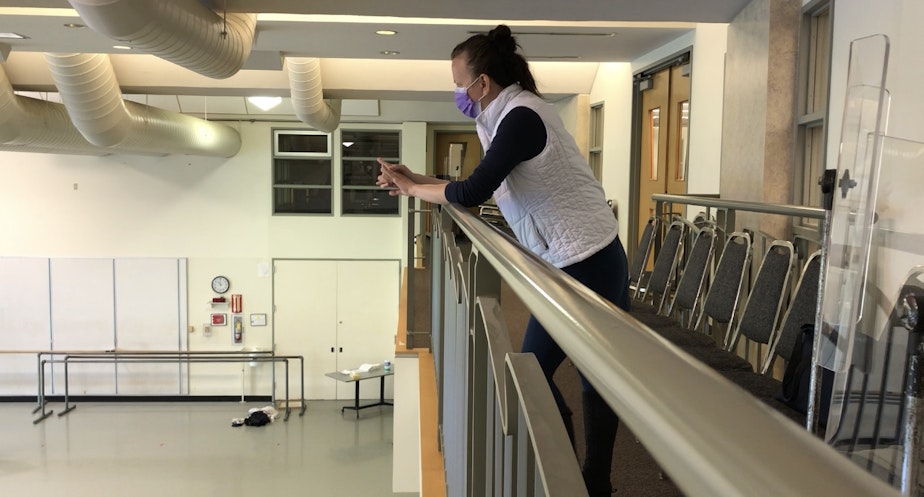Dancing in a mask and with a shadow: this is how Seattle's Pacific Northwest Ballet is making it work

On a late September afternoon, Pacific Northwest Ballet dancers and staff gathered at McCaw Hall to put the finishing touches on the first program of their new artistic season.
Musicians tuned up in the pit, dancers stood in the wings, and the stage manager called cues from her offstage perch.
But instead of performing for the hundreds of people who normally fill the hall for a dress rehearsal, the dancers did their best for a phalanx of video cameras.
“The lights don’t fade, no curtain comes down,” says soloist Dylan Wald. “No one’s clapping. It’s just very weird.”

More than seven months into the pandemic, performing arts venues in Washington state are still closed indefinitely. Many say they won’t reopen until September, 2021. But artists and arts organizations continue to produce and distribute new work, online.
This month, Pacific Northwest Ballet debuts the first all-digital artistic season in its 48-year history. Ellen Walker, the ballet company’s executive director, says in the first couple of months after the pandemic hit, she and Peter Boal, the artistic director, held out hope the virus would ease its grip so they could reopen to live audiences this fall; by June they realized that wasn’t going to happen.
“Peter said, ‘We have to pivot to digital, now!’”
It’s one thing to decide to transform a live artform intended for a large proscenium stage into dances that will look good on small computer screens. It’s quite another to execute that transformation, according to Boal.
“I have no idea how to do this!” Boal says from his office, just after the day’s rehearsals end. “I’m learning as I go.”
First he had to figure out how to safely bring back his dancers and staff. In consultation with the union that represents the dancers, Pacific Northwest Ballet instituted a strict regime of temperature checks, physical distancing and universal mask-wearing. Even when the dancers are rehearsing in the studios, they are masked.

The ballet company also divided the dancers into “pods” of four. For several weeks, they rehearse only with one another, a pianist and a director or choreographer. The dancers have no interaction with the other pods.
For acclaimed choreographer Jessica Lang, who Pacific Northwest Ballet commissioned to create a new digital ballet, the restrictions mandated a new way to work with the dancers in the studio, normally a very hands-on process. For everyone’s safety, the rehearsal studio was taped off into different sections.
“There was an outline of where I could go,” Lang says. “Each dancer had a quadrant.”

As if that wasn’t complicated enough, Lang decided to create a ballet for eight dancers, instead of the four in a single pod.
“I had two pods of four, and these pods were assigned to different studio spaces.”
They never met in the same studio. Beyond that, to keep the dancers healthy, they are only allowed to touch a person they live with. To get around that restriction, Lang had each dancer perform with a shadow cast by another dancer behind a screen. The idea was to make it appear to viewers that the dancer and the shadow were partners.
The physical distancing extends beyond the dancers in the rehearsal studios. Boal says everyone from costume designers to stagehands to the musicians in the ballet company’s orchestra observe the gathering limitations. That means only a few musicians can perform in the pit at any one time, limiting Lang’s musical options for her new ballet.
She chose a selection of piano solos by Robert Schumann, called “Ghost Variations.” They’re the composer’s last works, written as he was on the verge of an attempted suicide. “They’re not about this time, or this Covid experience,” Lang says. But she finds Schumann’s experience of mental instability very resonant in this era where so many people suffer from pandemic-induced anxiety and depression.
Lang’s ballet, “Ghost Variations,” will premier in November. It’s one of six new works commissioned for the ballet company’s unprecedented digital season. Pacific Northwest Ballet will restage and videotape past repertoire to fill out six evening-length programs that will stream between now and June, 2021.

Despite the challenges of an all-digital season, there’s at least one upside: it has pushed the ballet company—and all arts organizations--to fast-track a migration to digital, something they’ve been talking about for at least a decade. “There’s this whole opportunity around accessibility,” says Ellen Walker of Pacific Northwest Ballet. “Around sharing this art form with a lot of people. But it’s not the golden ticket.”
The price of a digital subscription doesn’t begin to cover the actual costs of stage and videotaping six full programs. “This is a loss-mitigation strategy,” Walker says. “It is not a revenue-earning strategy.”
That said, mounting the digital season has allowed PNB to rehire its artists and backstage artisans, at least on a part-time basis. And for choreographers like Jessica Lang, it’s an opportunity to push a very old art form in new directions.
While Boal, the artistic director, welcomes the chance to usher ballet into the digital age, he yearns for the day when he can welcome back live audiences to McCaw Hall.
“You know, it’s probably going to be only 400 or 500 people in the hall in the audience, if we’re lucky,” Boal says. “And I’m going to come out onstage and try to say something, and this is what’s going to happen.”
Boal turns his head, his eyes filled with tears. After a long pause, he continues.
“Hats off to all of us for finding a way,” he says. “But there’s something very magical about that moment of sharing together. It’s the height of humanity. I know we’re going to get back there.
“Just not tomorrow.”
Pacific Northwest Ballet opens its digital season, “Dance Happens Everywhere,” Thursday, October 15 with a program that will be available for five days.

